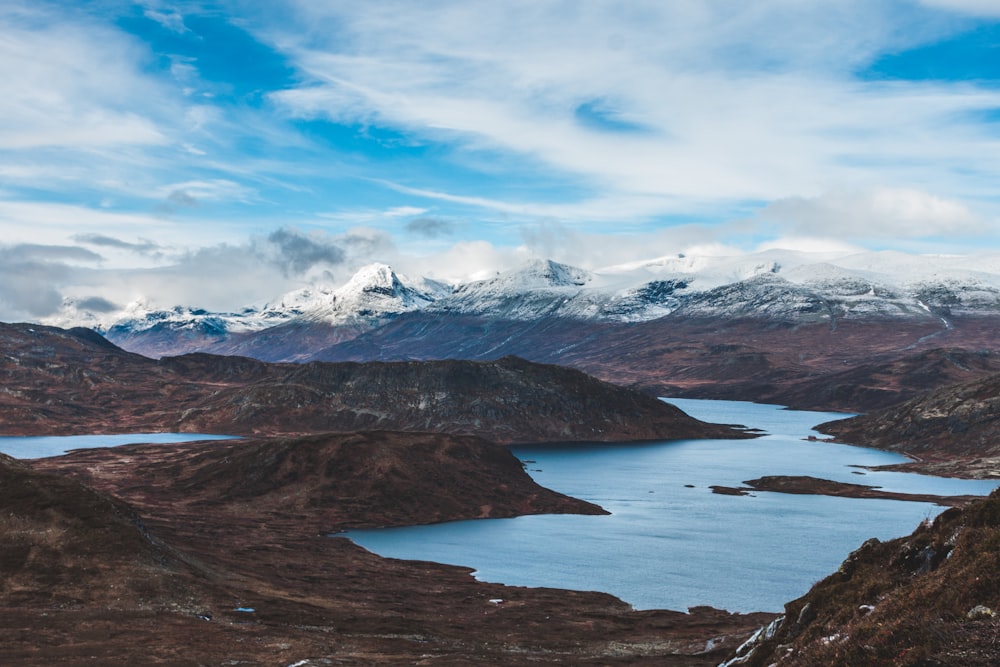Tonsberg. A NM “small town”, this is supposedly Norway’s oldest town dating to 1200 when fishing was the main occupation. The harbor is the main attraction. A long wood boardwalk fronts many busy and expensive restaurants (starters €12-14, burgers and pizza €19-21 and mains €30-33). Besides offering parking for boats, there are several ships in the harbor: the Kyrsten, an 1909 coastal steamer, the Benetine, an 1890 arctic sailing ship, and reconstructed Viking boats including the Oesberg shown in the Viking Ship Museum in Oslo. Held every day is a craft fair in tents with the staff dressed in traditional Norwegian clothes.

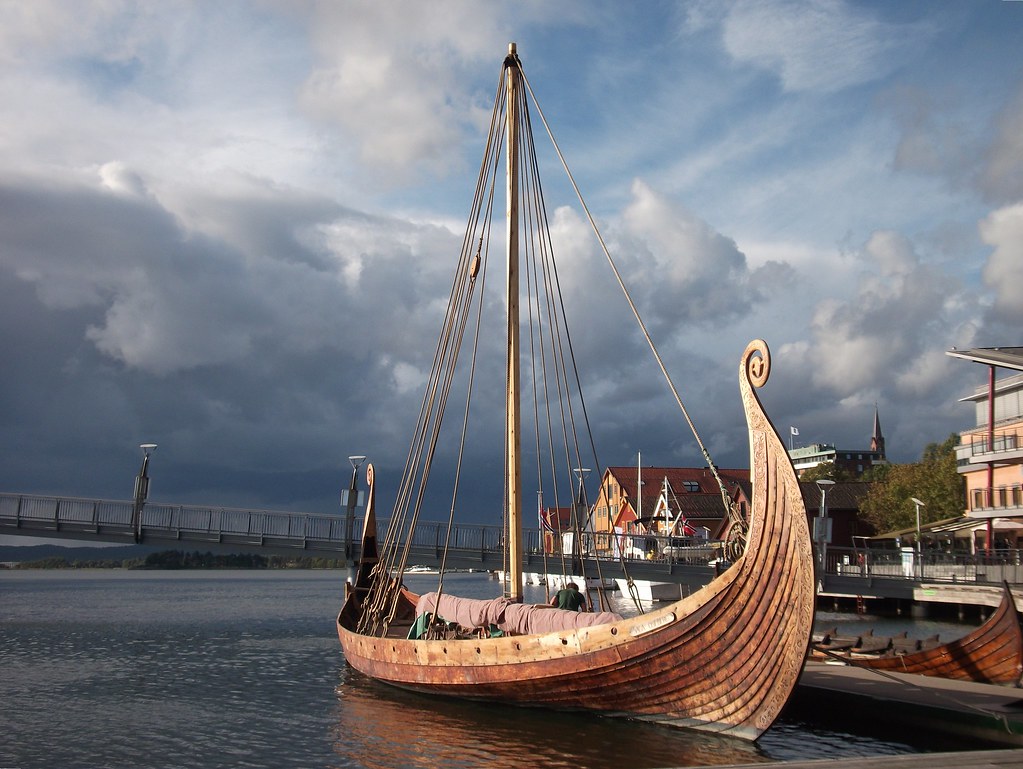
Surrounding the islands outside of Tonsberg is Færler National Park, a 340 sq. km marine reserve with 15 sq. km. of land.
SANDFJORD (pop 62,000)
This city is the most populous city in Vestfold County. The city is known for its rich Viking history and the prosperous whaling industry, which made Sandefjord the richest city in Norway. Today it has built up the third-largest merchant fleet in Norway. It is home to Europe’s only museum dedicated to whaling, and is home to Gokstad Mound where the 9th century Gokstad Ship was discovered. It is still considered a resort town with many visitors during summer months. Sandefjord has become a transportation hub, home of Torp International Airport, one of Norway’s largest airports. Daily ferry connections to Sweden are provided by Fjord Line and Color Line from the city harbour.
Sandefjord is the wealthiest city in Norway. Important industries in Sandefjord are information technology, chemical production, tourism, navigation, ship building and fishing. It is home to the international airport Torp Airport.
The largest employer, besides the city itself, is Jotun, which was established in Sandefjord in 1926. Jotun is now one of the world’s largest manufacturers of paints and coating products. As of February 2017, Jotun has a presence in over 100 countries and employed 9,500 employees world-wide. The second-biggest company is Komplett, a web shop operating in all of Scandinavia, Komplett had a 7.3 billion NOK revenue in 2015 and had 800 employees.

History. Inhabited for at least 3000 years, one of the most important remains from the Viking age was found at the grave site Gokstad Mound in 1880, the Gokstad ship now in the Viking Ship Museum in Oslo. The Viking, an exact replica of the Gokstad ship, crossed the Atlantic Ocean from Bergen to be exhibited at the World’s Columbian Exposition in Chicago in 1893. A replica of Gokstad ship, called Gaia, currently has Sandefjord as home port. Other known replicas include the Munin, (a half scale replica) located in Vancouver, Canada.
Sandefjord functioned as a seaport defined by the twin industries of shipping and shipbuilding throughout the 1600s and 1700s.
A fire in 1800 burnt down most of the town. The city became known as a world-renowned health resort destination between 1837-1939. Royalty and Prime Ministers from throughout Europe visited the town for its spas in the late 1800s. The original bathhouse has been restored and is now a culture house, the Kurbadet by the city center. It was one of Europe’s most visited baths until its closure in 1939.
Whaling. Sandefjord is perhaps best known as a whaling community and the city has been named the “whaling capital of the world.”
The centre of the world’s modern whaling industry was located in town, and Sandefjordians not only made up practically all the crew on the Norwegian whaling fleet, but substantial numbers of Sandefjordians also worked within the whaling industry in nearby countries. For over fifty years in the late 1800s, Sandefjord functioned as the world center for the whaling industry, including the manufacture and equipment of whaling vessels, floating factories and whale-catchers. From 1850, a number of ships from Sandefjord were whaling and sealing in the Arctic Ocean and along the coast of Finnmark. The first whaling expedition from Sandefjord to the Antarctic Ocean was in 1905. Towards the end of the 1920s, Sandefjord had a fleet of 15 factory ships and more than 90 whalers. In 1954, more than 2,800 men from the district were hired as crew on the whalers, started its decline in the mid-1950s and southbound expeditions rapidly decreased in the 1960s, with the 1967/68 season the last for Sandefjord. The shipping industry was gradually readjusted from whaling to other ship types during this period.
Whaling Museum (Hvalfangstmuseet). Today, the memories of this important period of the city’s history are kept alive here, the only museum in Europe specializing in whales and the history of whaling. The history of the whalers can also be explored at the Museum’s Wharf with a visit aboard the whale-catcher Southern Actor.
Nils Larsen (1900–76) was a sea captain from Sandefjord, famous for his expeditions of Antarctica in the early 20th century. It was under his expeditions that Norway achieved annexation of Bouvet Island in 1927 and Peter I Island two years after. A cove on Antarctica’s Peter I Island is named Sandefjord Cove and Sandefjord Ice Bay in continental Antarctica are also named after Sandefjord. Mount Nils Larsen in Queen Maud Land, Mount Nils in Enderby Land and Nils Larsen Glacier are examples of many geographical names given in honor of Nils Larsen.
Hans Albert Grøn of Sandefjord established the first whaling station in the Faroe Islands in 1894. Furthermore, Sandefjord was the headquarters of the South African Whaling Company (SAWC), which was established in in 1908.

LARVIK (pop 44,000 in municipality).
It was a market town dating to the 17th century and is the hometown of Thor Heyerdahl and the Norway’s only natural mineral spring. Larvik has a daily ferry connection to Hirtshals, Denmark.
Larvik Musuem. This city museum tells the history of Larvik as a seaside town. An exhibit is on Thor Heyerdahl (see Kon-Tiki Museum in the Oslo post.
Fritzøehus. This is another odd NM “palace” as it is private with no way to even see the house. Located just SW of Larvik, it is owned by the Treschow family and was built in 1886-8 and then expanded twice to 75 rooms and 21 basement rooms making it the largest private residence in Norway. It is located in 6.9 sq. km Fritzøehus Park, designated a conservation area for its large beech forests. In the courtyard of the house is a water fountain, all that can be seen through the locked gates.

STAVERN. This town is south of Larvik on the west side of a peninsula.
Fredriksvern Verft. This was a difficult NM site to find as it listed the sight as Stavern Fortress. This is a 1750 shipyard that produced 50 boats for wars with Sweden and then in 1814, became Norway’s main naval base eventually housing all four branches of the Norwegian military. It was closed as a military base in 2002 and opened to the public. The fort occupies a long piece of shoreline with a low embankment surrounding the many buildings and cannon.
SKIEN
Skien is one of Norway’s oldest cities, with an urban history dating back to the Middle Ages – it received privileges as a market town in 1358. Skien was Norway’s most important port town for shipping timber and fertilizer. The city was the birthplace of playwright Henrik Ibsen, and many of his famous dramas are set in places reminiscent of 19th-century Skien. I could not find the Henrik Ibsen Museum.
Skien Church. This 1894 Neo-Gothic church is 47m long, 17m high and has two 68m towers. It seats 1200. The organ is the largest in Norway with over 8,000 pipes. The primary decorations are the stained glass windows in the choir, transept, baptism, sacristy and the ornamented walls and ceilings.
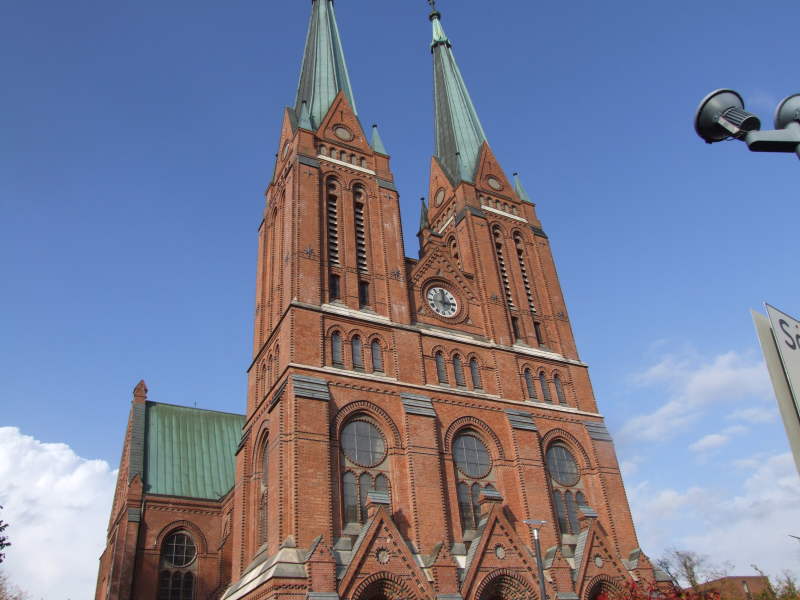
Telemark Museum. It was founded in 1909 at a farm surrounded by a 36-acre park with the farm house the main attraction. In 1911, three peasant huts were moved here and it has since developed into a large open-air museum with buildings from the Middle Ages until the 19th century, some with rose-painted interiors. Additional buildings were added in 1934 and 1958. The indoor museum has a special permanent collection of folk art from all over Telemark.
Driving in Norway can be very frustrating for all its speed zones. A significant part of the 100km drive from Skien to Arendal was on the E18, the main highway in the south of Norway and at a speed limit of 70-80km/hour. The highway is being completely rebuilt as a 2 lane divided highway.
Arendal (pop 42,000). One of the larger, south coast towns, it has a lively harbor and old district of Tyholmen with a core of half-timbered houses and off-shore islands.
I parked on the Arendal harbor and watched sailing for a few hours. Then I logged onto to the town free wi-fi and watched snooker on YouTube for several hours.
Little Torungen Lighthouse.
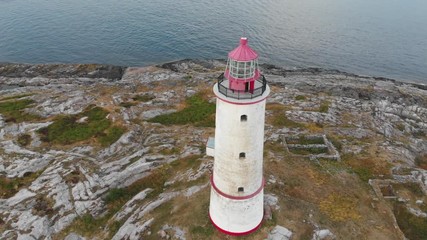
Sandvigodden Lighthouse. This is a coastal lighthouse located on the southeast shore of the island of Hisøya on the edge of the village of Sandviga. The light marks the west side of the entrance to the Galtesundet strait, which leads north to the town of Arendal. The lighthouse was originally built in 1844. In 1934, a new lighthouse was constructed right in front of the older tower. The new tower is 14 metres (46 ft) tall and is painted white with a red top. The light sits on top at an elevation of 14.3 metres above sea level. The light emits a white, red, or green light (depending on direction), occulting three times every 10 seconds. The light can be seen for up to 5.9 nautical miles (10.9 km).
Day 6
E18 improves with the highway twinned between Arendal and Kristiansand, a speed limit of 100km/hour and all the construction gone.
KRISTIANSAND (pop 88,000)
Norway’s 5th largest city, it styles itself as Norway’s #1 holiday resort, a bit misleading as sun-starved Norwegians come here in the summer and there’s a small beach and nice marina. It serves as the gateway to Norway’s southern coast and inland region of Selesdalen and has a lively cultural and shopping scene. The city was founded in 1641.
Kristiansand Dryrpark. 10kms east of Kristiansand, this former zoo is probably the favourite holiday destination for Norwegian kids. On an island, several parks are rolled into one, serving as a large amusement park: fun fair with amusement rides, Cardamom Town (fantasy village based on the children’s stories of Thorbjorn Egner), several water parks with heated pools, beaches and the biggest attraction, the zoo.
Kristiansand Domkirke. The present 1885 church is the fourth at this location: a 1642 simple wood church, a 1682 cathedral that burned down in 1734 and a 1738 cathedral that burned down in 1880. Only parts of this latter church remain in the choir. One of the biggest churches in Norway, it is 60m long, 38.7m wide and has a 70m bell tower with a great copper spire. The interior is flooded with light because the pillars are narrow with no arches separating the aisles from the nave and the high glass windows are pale pastel. It has a lovely pale wood ceiling and balconies, and several chandeliers. I arrived before service to hear the choir practicing. The coconut cookies were very good. Free

SKMU Sørlandets Kunstmuseum (Art Gallery). About a block east of the cathedral, this museum had exhibits featuring Axel Salto (1889-1961), a modernist ceramic artist with 100 pieces from his work at the Royal Copenhagen Porcelain Factory; Jacob Weideman abstracts; Between the Trees, works by 16 Nordic artists and Per Barclay known for his ‘oil rooms’ set in an old grain silo in Kristiansand. NOK 100
Vest-Adger Museet. On top of a hill overlooking Christianholm Fastning, there doesn’t appear to be a functioning museum here anymore. There was some cannon and artillery in the yard and great views down to the town.
D/S Hestmanden. This is a NM “ship museum” but was not where Google Maps took me to – the shore was a large construction site.
Kilden Performing Arts Centre. In he NM “modern architecture series” it was unfortunately closed unless performances are on at either the theatre or opera house. But the architecture here is best seen on the outside with a soaring wood front that curves and angles out like a ship’s prow. It is on the water next to where the ship museum D/S Hestmanden was supposed to be.

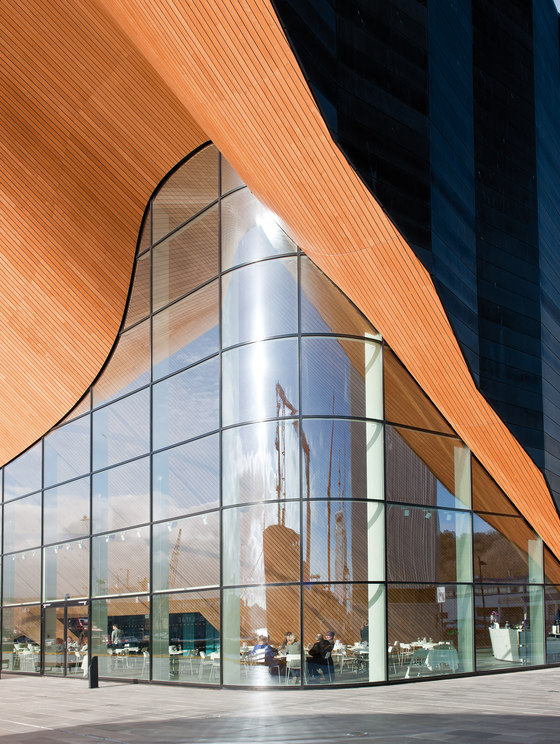
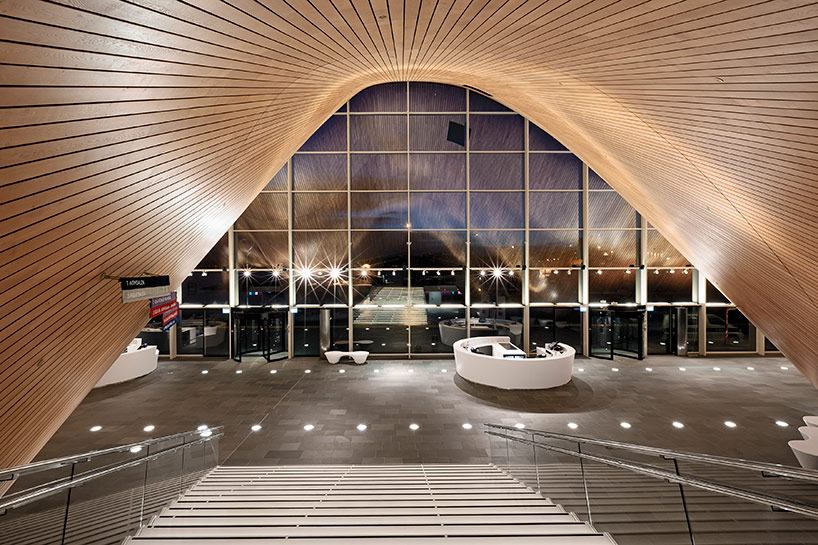
Christianholm Festning (fortress). In the harbour next to the marina, this round stone fort has a red conical roof and 3m stone walls surrounding it. It has modern glass windows under the roofline and looks more like a restaurant but was closed with no signs. Free

Adger Natural History Museum & Botanical Garden. This has the usual stuffed animal collection but it is quite dated and some of the specimens look a little worn. There’s an exhibit on plastic pollution in the oceans and a cactus garden. Unfortunately all is in Norwiegen, I had a look around the botanical garden: roses, monastic garden and a demonstration of plants introduced into Norway. NOK80
AROUND KRISTIANSAND
Vennesla Library. About 20kms north of Kristiansand, this building is actually the Kulturhus of the village of Vennesla, of which the library is one part. This building is in the NM “modern architecture” series. The façade is 2X12 vertical planks that project diagonally out from the face of the building. The inside is quite spectacular with a soaring roof supported by grand wood curved beams. The library is angled away from the reading area. On the west side is the old cinema, a lovely theatre. I arrived before the 10am opening time but the building was open as a local church was holding its Sunday service in the cinema – rock music and all.
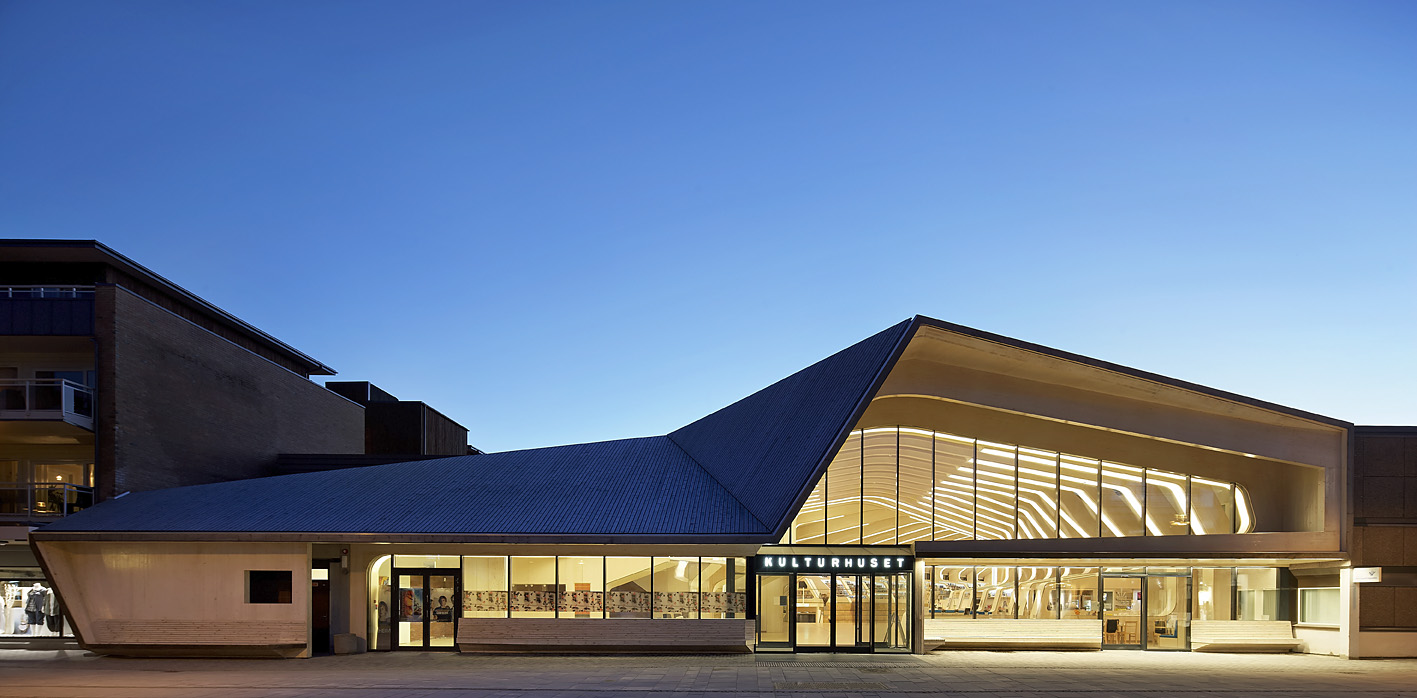


Movik Fort – Kristiansand Kanonmuseum. In 1940, the German forces began the construction of several costal artillery batteries including this one, Movik Fort, 10kms west of Kristiansand. Similar guns to the ones here were at Hanstholm in Denmark and with an undersea minefield that stretched from coast to coast, this was part of their WWII attempt to block the movement of Allied forces along Skagerrak Strait, the body of water between Denmark and Norway that is the entrance to the Baltic Sea. In the autumn of 1941, there were 1,400 men from Germany, Denmark and Norway plus Russian prisoners of war working here in the construction.
The batteries consisted of four 38cm caliber cannons manufactured in Germany by Krupp in Esssen.
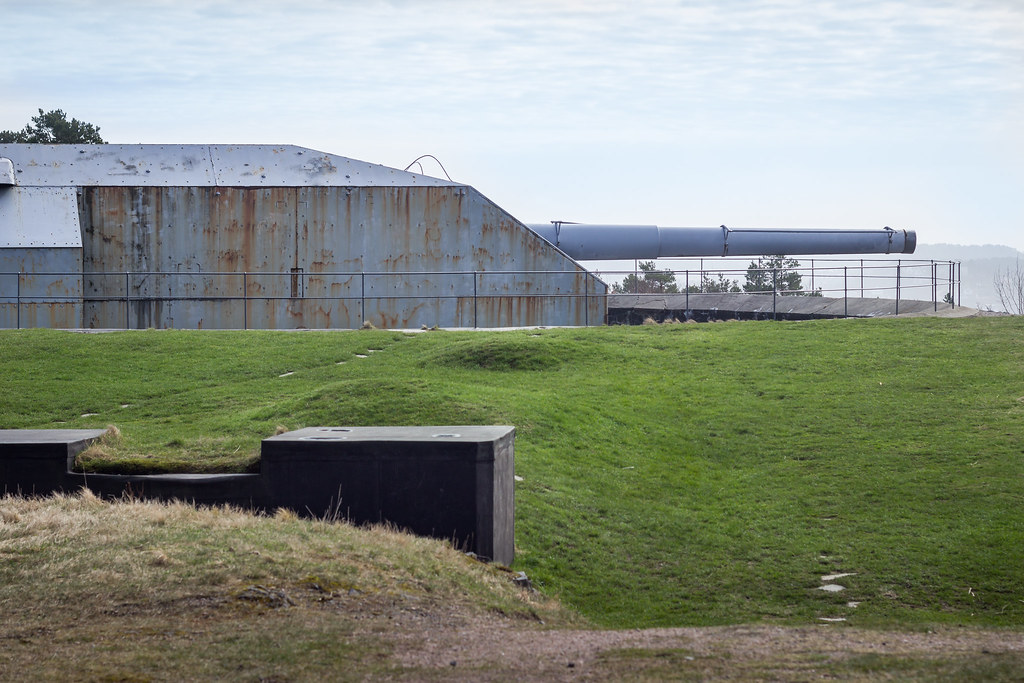
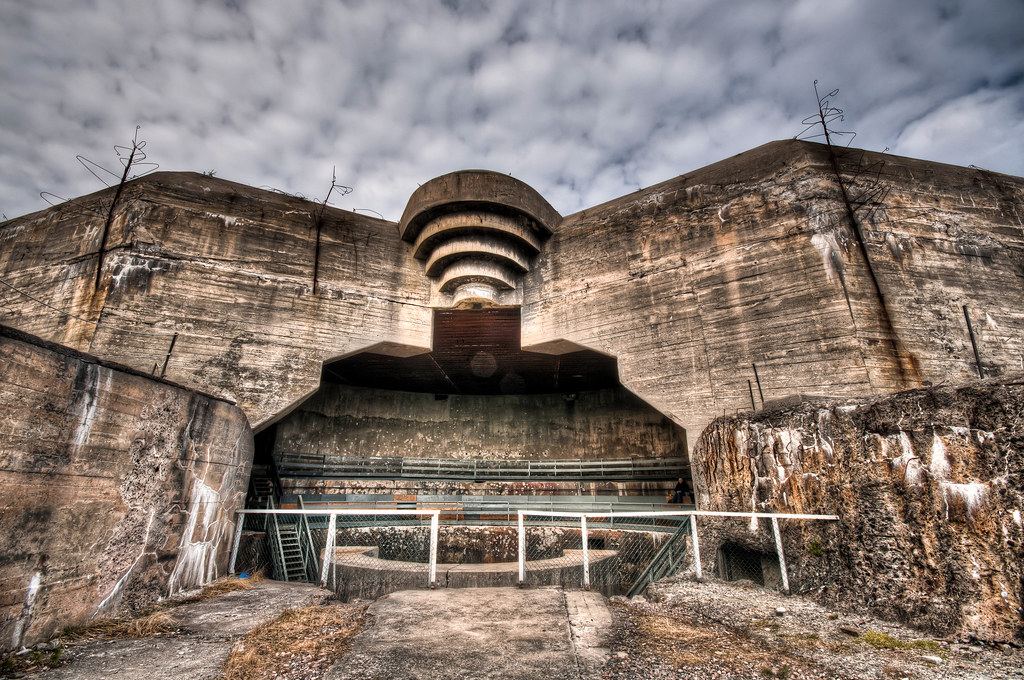
The guns were originally developed for the battleships Bismarck and Tirputz. Each cannon had a crew of 52 men and weighed 337 tons. Their range was 43kms with armour/high explosive shells and 55kms with the Siegfried shell, and thus able to cover almost the entire strait. They could fire at the rate of one per minute. At the end of the war, there were 1436 shells stored in the fort: 200 in each gun’s ammunition bunker, 100 at each gun and the rest scattered around in the open. The last shell was test fired in 1957.
The fort consists of an underground museum under the main hill with one cannon in its huge metal housing, still present and three large concrete batteries pointed in different directions. There is a reconstructed 2km-long munitions railway that carried shells between the munitions depot and the canons. NOK90
Oksøy Lighthouse. On the outermost island in Skaggerak Strait, the very most southern point of south Norway, is this white lighthouse with two red horizontal bands. It is not possible to go to the island but I had great views of it through binoculars from Movik Fort.
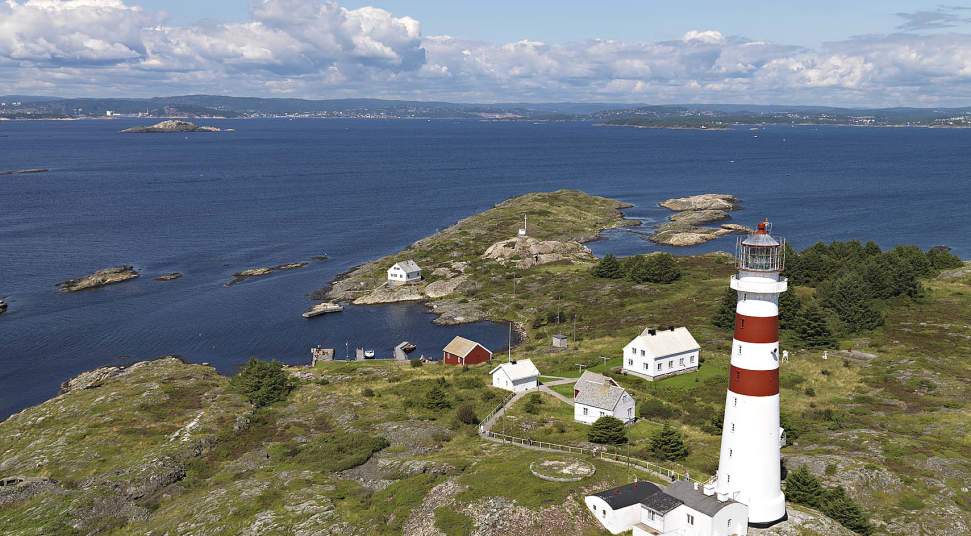
MANDAL. This small city is 44kms west of Kristiansand on the coast. The main part of the town staddles the Mandalselva River that empties into Mannefjord. During WWII, it served as the main air base for the Germans.
Vigeland Hus. Gustav Vigeland (1869-1943) and his brother, Emanuel (1875-1948) were raised in this small white house in Mandal. Purchased in 1868, it was sold when their father died in 1886. The house is part of the Mandal Museum open only from June 20 to August 15. The museum offers guided tours of the house with its small sculpture garden and has drawing workshops. NOK90
Gustav was Norway’s premier sculptor (much of it in Vigeland Park in Oslo) and Emanuel was one of Norway’s foremost church artists known for his stained glass painting.
Adolf Tidemandsbro Bridge. This is a spectacular pedestrian bridge in the centre of downtown. It connects to the south side of the river and the Buen, a lovely cultural centre.
 Uranienborg. This rocky promontory above downtown is accessed from a stairs near Vigeland Hus. There is a nice white pergoda on top and great views down to the town.
Uranienborg. This rocky promontory above downtown is accessed from a stairs near Vigeland Hus. There is a nice white pergoda on top and great views down to the town.
The drive up the south west coast of Norway took me along the narrow E39 that goes inland instead of along #44 that follows the coast. This was a spectacular drive though rugged, forested mountains, rivers, lakes, reservoirs, one fjord and a maze of tunnels.
Day 7
Egersund. In the Nomad Mania “small town” series, there is not much here, a cute little downtown and a river that empties into a fjord, not really worth the 12km drive off E39 to get there.
Instead of returning to E39, I took #44 along the coast to Stavanger. Don’t miss this drive. The first 20kms is through a wonderland of weather eroded rock and boulders punctuated by small tarns, some next to open ocean and rocky bays.

After being close to the rocky shore for a few kms, hit the flattest landscape I have seen in Norway, green fields and farms and a great collection of dry stone walls. I can’t imagine the amount of heavy lifting that was required to clear all the boulders from this land to make it suitable for cultivation. Occasionally you pass pastures not cleared – and there is a lot of rock.
Vitenfabukken, Sandnes. Sandnes is just south of Stavanger. This is a science and industry museum. The science part has many interesting exhibits: the brain, a planetarium and the industry emphasizes the textile and pottery industries that thrived at one time in Sandnes. NOK130
STAVANGER (pop 124,000)
Known as “Norway’s oil city” (it is twinned with Houston and Aberdeen Scotland), it is the home of Statoil, Norway’s largest oil company. North Sea oil has funded almost all of Norway’s development since the 1970s. There are no skyscrapers and it has a an old centre with well preserved wooden buildings. The oil boom has made it the priciest city in Norway, a country known for its eye-watering expense.
Norsk Oljemuseum. (Oil Museum). Housed in a striking steel clad and black stone structure, it has high tech displays exploring the history of North Sea oil exploration. Highlights include explanation of why the North Sea has oil, the importance of oil revenue to Norway, drilling and oil platforms and much about the mechanics of offshore oil like helicopters, divers, lifeboats and underwater vehicles. NOK120

Stavanger Maritime Museum. On the harbor opposite the cruise ships, this is a typical maritime museum with lots of models. The trade with the Lithuanian city of Klapeda was pivotal in Stavanger’s growth – salt, herring, coal and luxury goods were traded for timber, flax, hemp and grain.
Stavanger Domkirke. This is the best-preserved medieval church in Norway. It does look old with its simple stone construction. It has had many restructurings – two towers date from the 13th century and the stained glass from the 1950s. NOK50
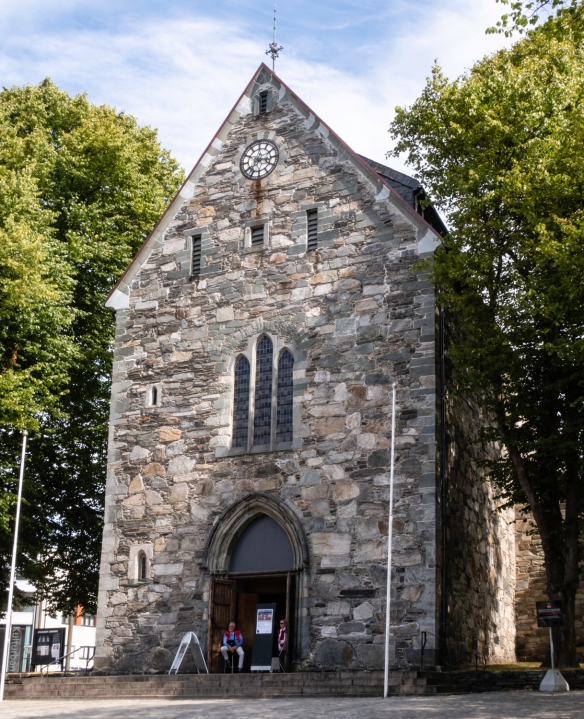
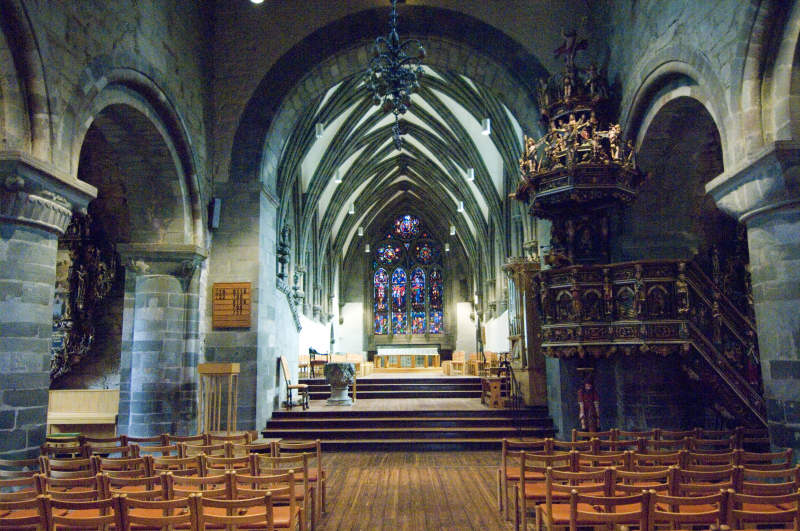
Stavanger Museum. The city museum tells Stavanger’s history form an impoverished town in 1820 with only 2,000 people to a thriving city based on herring and trade in 1860 with 25,000 people. The role oil has played is emphasized. NOK80
Arkeologisk Musuem (Archaeology Museum). Unfortunately this museum was undergoing a renovation and only a small exhibit was available. Some of the highlights were: rune stones, the gold Bokn buckle, Foldøy coin hoard, Avaldsnes gold arm ring, Stone Age skeleton 8,200 years old, bronze lurs (a long curved horn) and many other one-of-a kind treasures. Amazingly this museum if free, the only one I have seen in all of Norway.
Breidablikk. The villa Breidablikk was built in 1881 by Lars Berentsen, a leading merchant and ship owner in Stavanger. It was designed in the Swiss style unique for the period in which it was built. Breidablikk remained in the Berentsen family’s possession until 1965, and it was given in its entirety to Stavanger Museum in 1989. Learn the story of the Berentsen family and the life of Stavanger’s upper class in the latter half of the 1800s. Rooms on three floors of the villa are open to visitors. Few changes were made to its original interior from 1881, Victorian style popular in the late 1800s – furniture, opulent chandeliers, ceramic stoves, flower arrangements, small decorative objects and bits and bobs. The house also contains a large art collection especially by Kitty Kielland and other famous Norwegian artists.

The ground floor has a library, living room, salon, ‘smoking room’ and the dining room set for a dinner party. The first floor has four bedrooms and the basement a laundry room showing a washboard, washtubs and large pot for heating water. There are also a pantry, wine cellar and the bomb-shelter that the family installed in 1939. The barn has farming implements and horse-drawn vehicles. Breidablikk’s park is also worth visiting. There were no signs on the building indicating it was a public building.
Ledaal. Across the road from Breidablikk is this manor house built between 1799 and 1803 by the merchant and leading citizen in Stavanger, Gabriel Schanche Kielland (1760-1821). He gave the estate its present name after the last letters of his and his wife’s names: Gabriel Schanche Kielland, Johanna Margaretha Bull. Ledaal was bought by Stavanger Museum in 1936. The estate is today a royal residence, a museum and the representation building of Stavanger municipality. It served as the official residence of the King of Norway in Stavanger.
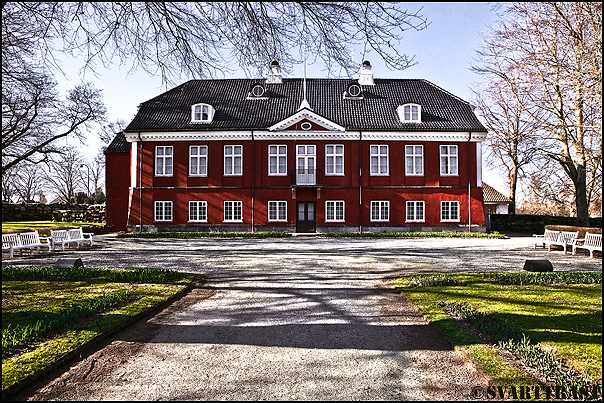
It sits in at the end of a long drive surrounded by mature trees. The windows were all shuttered and it is closed to the public. Next to the left wall is a memorial to several members of the original families: Kielland, Schiotz and Bull.
LYSEFJORD
This 42km-long fjord east of Stavanger is on many visitors bucket list. Many see the fjord on cruise boots, but it is a common destination for tour buses and easy to reach by vehicle. Take a ferry from Lauvvik to Levik (NOK82) and climb up to the parking lot to see the highlight of Lysefjord.
Preikestolen (Preacher’s Pulpit Rock). I decided to not pay the NOK100 parking fee and parked just outside the gated parking lot, not really knowing where the “rock” was. I asked and found out it was a 4km walk, much to my surprise.
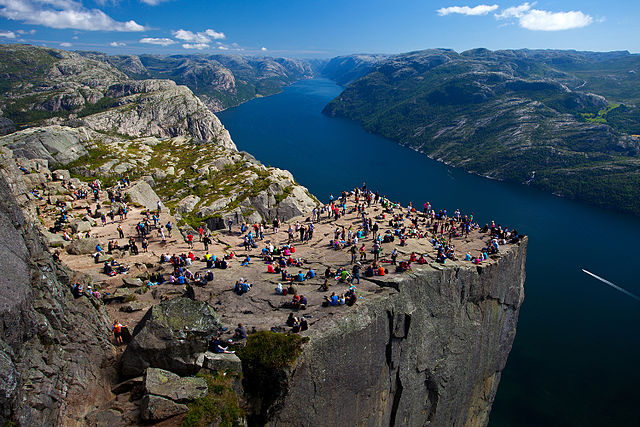

And it was a wonderful walk on one of the nicest constructed trails in the world – all large rock carefully placed to make stairs and deal with creeks. Uphill most of the way, it took me 1¼ hours at my steady pace t reach the narrow ledge above the 600m sheer drop just before the Pulpit. It. The entire place was enveloped in cloud – all that was visible was wide ledge full of people – all a little underwhelming as it was not possible to see anything. I waited around and the cloud miraculously lifted for a few minutes to give spectacular views down to the fjord. It ended up being worthwhile after all. I virtually ran back down in an hour. I didn’t have a parking ticket! Another €10 saved.
Kjeragbolten. This is the other highlight place on Lysefjord but reached by an entirely different road and a more difficult hike. I believe the way is by ferry up Lysefjord to Lysebotn. Then climb the much photographed narrow road that corkscrews 1000m in 27 hairpin turns.
You may well have seen photos of people standing on a boulder wedged between two sheer cliff faces.

I had decided to drive from Stavanger to Bergen a long time ago. It seemed natural – there was a big red line highway all the way. After going to Preacher’s Pulpit Rock, I put Roldal Stave Church as my destination – 160kms and 3½ hours!! Google Maps took me over a pass with dirt roads that eventually arrived at a good highway. Then I hit a ferry across Jøsenfjorden from Hjelmelands to Nesvik (NOK82). All traffic disappeared and the road was a wide one-lane that followed the north shore of Jøsenfjorden, a wide body of water that looked like fjords are supposed to, with high rock walls and lots of waterfalls. It was 8pm so I pulled over on the side of the fjord to eat and sleep. After almost two hours, only one car passed me! Do people normally drive to Bergen? And if they do, do they go this way? As I sat and pored over the map with my magnifying glass, I worried that the answer to both questions was no. With the myriad ways to get to Bergan, all involving multiple ferries, I decided to sleep on it.
Day 8
From the fjord, the road switchbacked up and over a high pass, along Sandsfjordsen and turned up the Suldalslagen Canyon, one of the largest rivers in Western Norway. Only 22kms long, the two dams on it generate 9% of the total electricity in Norway. The canyon itself is fantastic with massive rock walls and waterfalls streaming down the cliffs.
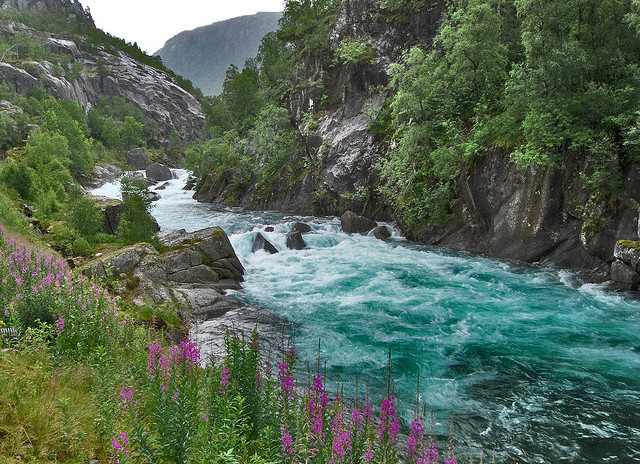
Svandalsfossen is the largest falls and a spectacle. The river originates in the long

The river originates in the long Suldalsvatnet Lake and the road passes through at least 9 tunnels along its shore. I finally reached Røldal after 1½ hours of twisty mountain driving. Even if this turned out to be the wrong way, it was a stupendous drive, one of the great scenic drives in the world.

RØLDAL. In 1000, this town had 100 citizens. The church was built in 1275. At the end of the 19th century, the first roads reached it. A cheese factory was built in 1913. In the 1960s, a new road was built that connected west and east Norway that was open in the winter. Traditional farming disappeared as the farms were not large enough to support a family. Hydropower facilities are a major employer. The town is on exactly the same latitude as Oslo.
Røldal Stave Church. Unfortunately the church was closed and I could only peer through the windows. I’m not sure how unusual this is, but a relatively modern wood church completely enclosed the stave church and I could only see its exterior walls.

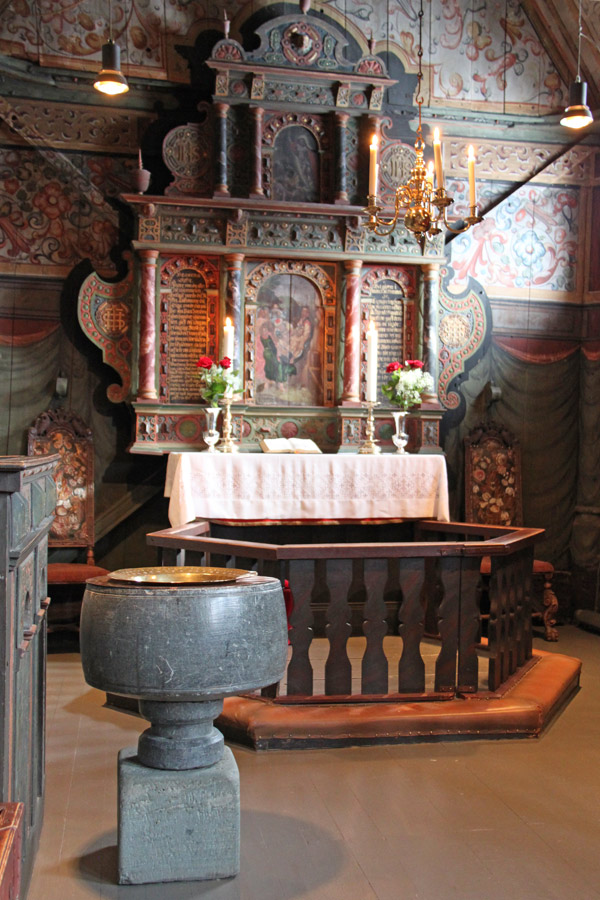

Røldal turned out to be an auspicious stop as it was the hub of all the driving options available to me. West it was 175kms to Bergen (3’ 32”), northeast it was 397kms to Lillehammer (6’ 25”) and east it was 306kms to Oslo (4’ 42”).
For many reasons, I decided to abort any trip further north, return to Oslo and Sweden. There were not many worthwhile sights where I was.
The drive on Highway E135 east of Roldal through spectacular alpine terrain – a huge plateau with Stavatn Lake.

Other sites: There were a collection of other stave churches (Undredal, Kaupanger and Borgund).The sights I don’t like to miss are the UNESCO WHS sites: Bryggen, the old town of Bergen, Urnes Stave Church


 Geirangerfjord
Geirangerfjord

Nærøyfjord
These two fjords at the terminal end of Storfjorden have huge cliffs, tumbling waterfalls and 600,000 visitors per year as many cruise ships travel all the way up to see them. But they are a long ways north of Bergen and driving is not the usual way to see them.

Monk Steps, Loftus
 Vøringsfossen
Vøringsfossen
 Kjosfossen
Kjosfossen
 Sognefjorden – world’s second longest fjord at 203kms and Norway’s deepest at 1308m
Sognefjorden – world’s second longest fjord at 203kms and Norway’s deepest at 1308m

Flåmsbanna Railway

Brigsdalsbreen Glacier

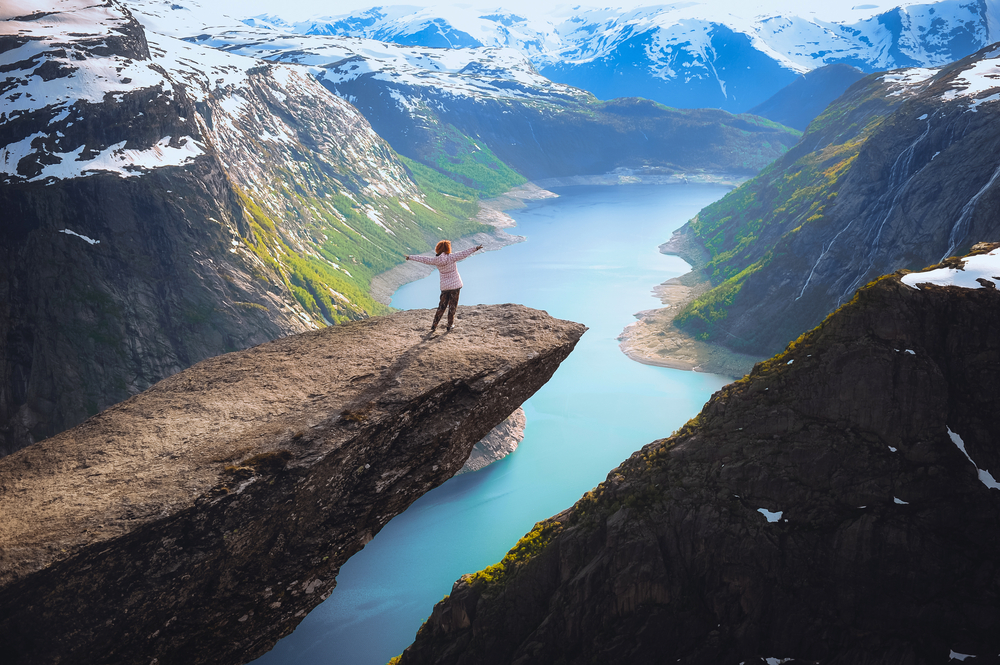
Trolltunga

Trollstigen National Park
Jotunheimen National Park
I was tired of the over-the-top Norwegian prices. I could not bring myself to pay for the groceries and was missing salad. Other than gas and museums admissions, I only spent €3.
My Schengen visa was up on September 27 and I still had most of eastern Sweden, Finland, Estonia, Latvia and Lithuania to see. I will probably have to overstay my 90 days to see them all.
Day 9
I returned to Sweden on September 12 hoping to be on the ferry to Finland by the 17th. It will be nice to get back to reasonable prices (by European standards) and sane highways with no tolls and reasonable speed limits.
